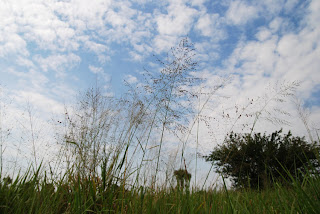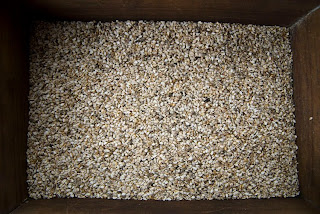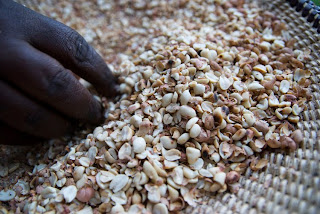This is the swamp area between downtown Gulu and the area where my office/home are. It is at once beautiful and trashed.
Wednesday, August 25, 2010
Monday, August 23, 2010
Travel to the field: Apaa
We finally made it out to the field this week for work. On Wednesday we traveled north west of Gulu to Apaa. Our final destination was a transit camp on the border with a game reserve. A couple weeks ago the game rangers came and burned down 180 huts, claiming that people were living on game reserve land. The people were moved off of their land by the government to Internally Displaced Persons Camps in 1996, and returned in 2006.
The issue here is that the land was gazetted by the government (made to be game reserve land) in 2002, while the people were absent from their homes. The injustice is clear, but so far the justice system has failed to help these people. The game rangers have given them until Aug 23 to move off of the land, but the people said they are planning to stay put.
Part of the problem is that Apaa is in a remote area and is hard to access. The road we used was full of potholes that we called 'swimming pools': they were large and deep. At times the road narrowed to such a degree that the front windshield was continuously slapped by tall grasses and branches. Those on foot or on bikes would leap out of the way of our vehicle, crushing up against the tall grasses and pulling their bikes, children, or goods along with them. We were deep in an area that the rebel group used to control, and now I can see very clearly why it would be so hard to gain control of this area, let alone find anyone.
The issue here is that the land was gazetted by the government (made to be game reserve land) in 2002, while the people were absent from their homes. The injustice is clear, but so far the justice system has failed to help these people. The game rangers have given them until Aug 23 to move off of the land, but the people said they are planning to stay put.
Part of the problem is that Apaa is in a remote area and is hard to access. The road we used was full of potholes that we called 'swimming pools': they were large and deep. At times the road narrowed to such a degree that the front windshield was continuously slapped by tall grasses and branches. Those on foot or on bikes would leap out of the way of our vehicle, crushing up against the tall grasses and pulling their bikes, children, or goods along with them. We were deep in an area that the rebel group used to control, and now I can see very clearly why it would be so hard to gain control of this area, let alone find anyone.
On our drive up north.
Neatly planted bean field.
Family working in their field along the road.
The first of many 'swimming pools' that we crossed through. Our driver said it was the worst road he has ever seen, and will never go back there again.
We came across IDP camps, transit camps, villages, and trading centers. Most of the IDP camps have been dismantled but many people and their huts remain around the trading centers.
Most trading centers consist of several buildings along a road and sometimes include a small market.
This is at the Apaa transit camp. The building furthest to the right is the school. Since they are so remote, they have a hard time keeping teachers and only go up to Primary 6. We met with Local Council leaders, teachers, and other community members under a tree. We were not able to actually travel to the area where the huts were burned because the road was inaccessible by vehicle.
Sugar cane is in abundance here, so we stopped to buy some on the way back. Only 15 cents for a pole of sugar cane. It is eaten as a snack, but I can't imagine it is good for the teeth.
A view of one of the roads we traveled along. At times the brush was nearly two feet taller than people.
One more typical view out the front window. After nearly 6 hours of travel in the car, we were happy to be home, and I was asleep by 9:30pm.
Friday, August 20, 2010
fog
We awoke to a foggy morning last Tuesday, the first of its kind that I have seen here. But, don't worry the sun was shinning hot and bright by afternoon...
Thursday, August 19, 2010
We made odi!
Odi is a ground nut and sesame seed paste: somewhere between peanut butter and tahini. It is quite fluid and used in so many dishes here in the north. It is mixed with different kinds of greens (similar to spinach) to make side dishes like boo and malakwan. The next adventure will be learning how to cook these. For now we use odi on bread, in oatmeal, and to make peanut sesame noodles.
A couple weekends ago I spent the afternoon with Lucy, a coworker, to clean, roast, and clean again the ground nuts and sesame seeds in preperation for grinding the nuts and seeds into paste. It was quite the process!
A couple weekends ago I spent the afternoon with Lucy, a coworker, to clean, roast, and clean again the ground nuts and sesame seeds in preperation for grinding the nuts and seeds into paste. It was quite the process!
Lucy's home.
We started with 3 kilos of ground nuts and 2 kilos of sesame seeds.
Lucy roasted the ground nuts over a charcoal fire.
Lucy sifts the sesame seeds to get rid of dirt, worms, and little bugs.
The sesame seeds in the sifter. The seseame seeds were also toasted once they were clean of debris.
Lucy breaks the skin off of the roasted ground nuts.
Showing Lucy's daughter, Claire, how to use my camera.
Breaking the skin off to the ground nuts, following Lucy's example.
Seperating the skins from the ground nuts by tossing them into the air (the lighter skins fly away).
Lucy doing a final sorting of the ground nuts.
Our final product- roasted ground nuts and toasted sesame seeds, ready to be ground into paste!
Lucy and I took our bucket of ground nuts and sesame to this home for the grinding.
Weighing our nuts and seeds.
Pourin the nuts and seeds bit by bit into the grinder.
Pouring in more nuts and seeds. We sat under a tree in her garden between pourings, spending about an hour at her home before the paste was smooth enough.
The finished product: odi (groundnut/sesame paste).
Pouring the hot odi into my bucket for transport home. I had to delicately hold the top of the bucket on the boda ride home. Let's see how long the odi lasts in our home!
Friday, August 6, 2010
Scenes on my way home
 |
| You have to be all eyes and ears when walking here. Watch your step and listen for boda bodas driving up behind you so that you can get out of their way. |
 |
| Our house is on this road just around that bend on the bend on the right. |
Wednesday, August 4, 2010
tea time
Tuesday, August 3, 2010
Maps of Gulu
I drew a rough map of Gulu, the first is Senior Quarter and the second is of downtown. There are so many more buildings than what I have marked, but these are the highlights of places that I go to regularly. Click on the map to enlarge the image.
Monday, August 2, 2010
Sudden Rain

I went to the small town of Alero, west of Gulu in Amuru district, with some of my coworkers for a seed distribution. In an effort to protect social and economic rights, HURIFO (Human Rights Focus) distributed seeds to a group of women and a second group of youth for them to plant together. Just as we finished the distribution a heavy rain swept through, catching this young boy under this tree.
Subscribe to:
Comments (Atom)





































